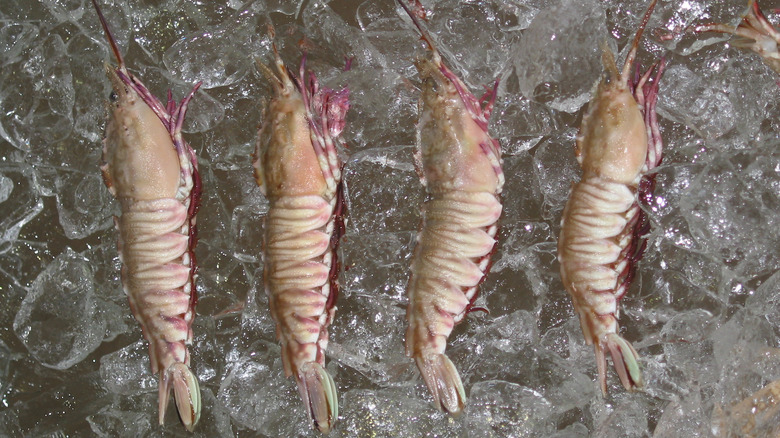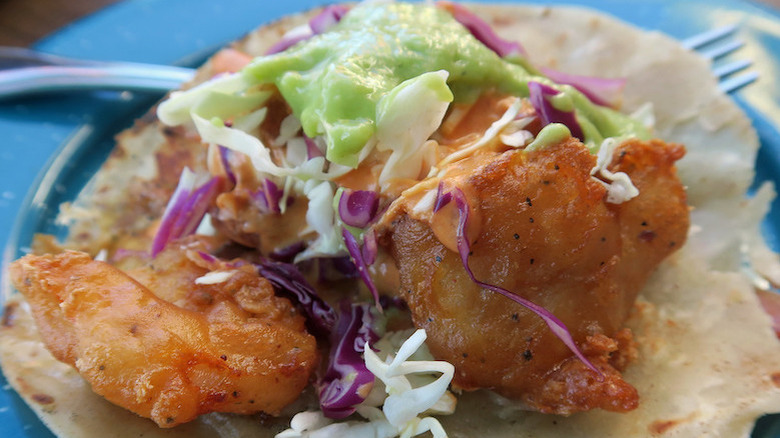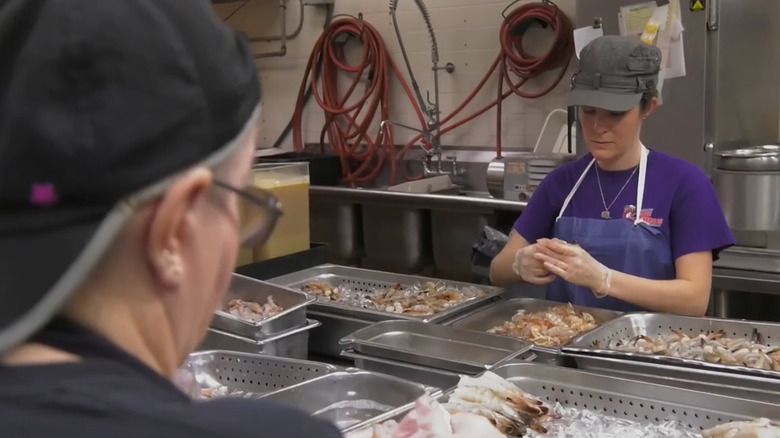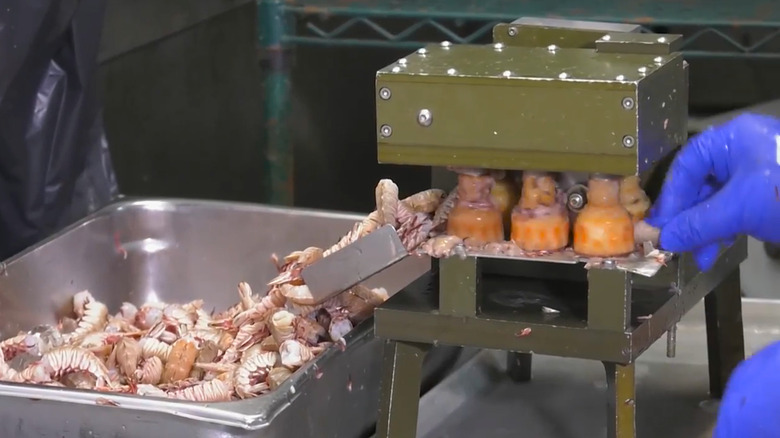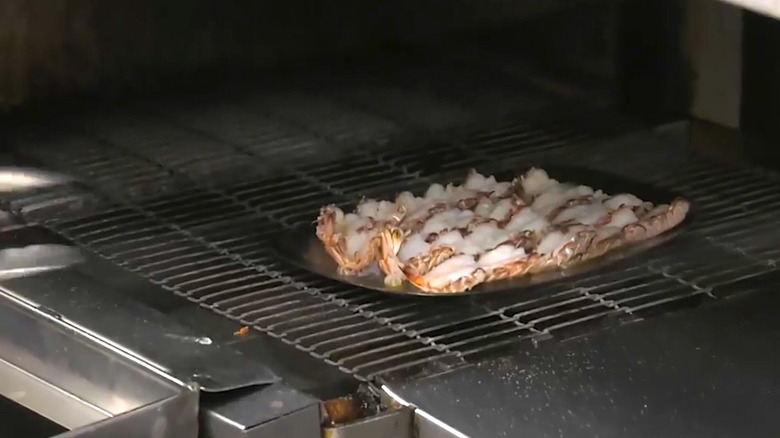The Reason Rock Shrimp Were Almost Never Brought To Market
One man's trash is another man's treasure. That simple saying sums up the story of how a Florida boat builder-turned-fisherman came to introduce the world to rock shrimp. It's difficult to imagine now, but back in the 1970s, shrimp trawlers hauling catch off the southeastern coast of the U.S. routinely dismissed a particular variety of shrimp as not worth the effort.
According to NOAA, Sicyonia brevirostris, more commonly known as rock shrimp (in reference to its rock-hard shell) is the deep-water cousin to more widely known varieties including white, pink, and brown shrimp. They thrive at depths of 80 to 215 feet, and usually burrow in sandy ocean beds during daylight hours. Some observers swear they look like tiny lobsters, but they most definitely fall into the shrimp family.
Interestingly, the guy who cracked the market for rock shrimp, wasn't even a fisherman by trade. According to the Titusville Area Chamber of Commerce, he was the owner of a boat-building business that bucked the conventional wisdom of the time and sold fiberglass-hulled fishing boats as a replacement for traditional wooden trawlers. But both of his pursuits (boats and shrimp) would require time, patience, and perseverance to pay off.
The big break
In 1968, Thompson debuted his state-of-the-art fiberglass shrimp trawler, the R.C. Brent Jr., to little acclaim. Unfortunately, traditional shrimpers at the time weren't ready to embrace Thompson's fiberglass technology. With a growing family to support and boat sales on the wane, Thompson set out to prove the superiority of his fiberglass design — by going fishing.
But Thompson had little luck when it came to cashing in on a big haul — until the day he and his crew pulled into their Port Canaveral berth adjacent to a slip occupied by Oregon II, a NOAA research vessel. Legend has it, the captain of the NOAA boat noticed the empty hold and made an off-the-cuff offer, shouting, "Do you want to make a million dollars? I'll show you how," (via the Titusville Area Chamber of Commerce). Intrigued, Thompson made plans to follow the NOAA vessel to a location 20 miles off the coast of Melbourne, Florida.
The catch that day? More than a thousand pounds of shrimp. The problem was that they were the hard-shell variety — also known as hardheads or rock shrimp — the same tough-guy crustaceans generations of fishermen had written off as a trash catch. Not to be deterred — Thompson's life motto was, "Always ask how, not why" — he recruited his four children to come up with an easy way to open the hard-shell shrimp. And those kids did what no fisherman had been able to do. They figured it out.
The Eureka moment
According to an Associated Press report, it took months of trial and error, but one day Thompson's eldest daughter, Laurilee, had an ah-ha moment. "We were sitting there in our misery one day, wishing we were playing pool and riding horses," Laurilee recalled in 2018 of the moment she used a steak knife to cut a few shrimp open along their undersides. At that point, Thompson's wife, Mary Jean, jumped into the fray, quickly melting butter, pouring it over the shrimp, and tossing them under the broiler while the entire family waited with bated breath for two minutes — which must have seemed like hours — watching the shrimp meat curl up and pull away from the shell. They hit the jackpot. The rock shrimp not only looked like tiny lobsters, they also tasted like it too.
Although Thompson and his family had succeeded in finding a way to open and cook rock shrimp, it was still a labor-intensive process. So, the man known for asking how before why, came up with a plan. According to the Associated Press, he recruited neighborhood kids to form an after-school assembly line in his kitchen — crack, wash, pack, repeat — as he built a customer base of bars and restaurants in and around Titusville.
The invention that changed the industry
With the business growing in leaps and bounds, Thompson's home-grown production line couldn't keep up with demand, so he went all in by renting space, hiring bonafide employees, and even using a sewing machine motor and a vacuum cleaner belt to jerry-rig the first-ever automated rock shrimp-splitting device (via Associated Press). "My dad was the one that created the very first rock shrimp splitting machine, and no one's created anything else like it since then," recalled Laurilee Thompson during a 2021 interview with Orlando's WUCF-TV.
Following a few twists and turns, Thompson and his wife, Mary Jean, opened their own restaurant, Dixie Crossroads, in 1983. What began as a 30-seat seafood joint is today an iconic, still-family-owned, landmark with seating for more than 400 patrons (via Visit Florida). Rodney Thompson died in 2016 at age 86, but his legacy lives on. In the 2021 WUCF-TV interview, then Dixie Crossroads general manager Greg Holladay demonstrated the updated version of Thompson's original shrimp splitter, telling a reporter, "We split it open here. We take it to our shrimp ladies that are sitting at a table. They clean it, spray it onto little broiler plates, and then spray butter on it, send it through a broiler oven, then it goes to the customer. We just want everybody to be able to have fresh Florida seafood, so we go through all this labor-intensive stuff so customers can have a really good, fresh product to eat."
So about that rock shrimp?
Thanks to the Thompson family's determination, rock shrimp is widely available today. According to FoodReference.com, it's sold fresh, frozen, and sometimes pre-split. Like other varieties of shrimp, you can buy it with or without the heads. For a point of reference, if you choose to do the splitting yourself, two pounds of headless rock shrimp yields about a pound of shrimp meat. And also like other varieties, rock shrimp are priced by size, measured in the number of shrimp per pound. The higher the number, the smaller the shrimp. Bought fresh, they'll last in the refrigerator for up to two days, or can be stored in the freezer for up to six months.
The original preparation the Thompson family came up with the day Laurielee successfully opened a rock shrimp remains a favored cooking method. If you're up for the challenge and want to follow it from start to finish, FoodReference.com suggests individually splitting each shrimp on a cutting board. To do that, place the shrimp backside-down with the swimmers facing up, and use a sharp knife to split the shell from tail to neck. Spread at the opening and rinse the visible sand vein away. When you've had enough of that — or enough for a serving — place the prepared shrimp on a broiler-friendly pan and cook 4 inches from the heat source for 2 minutes. Then drizzle with melted butter.
